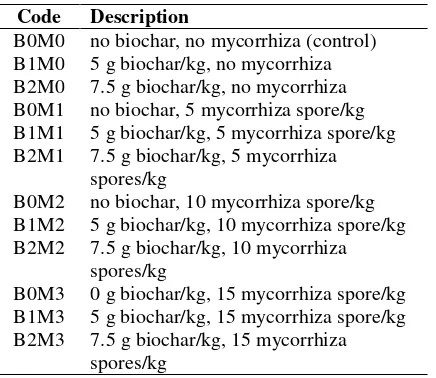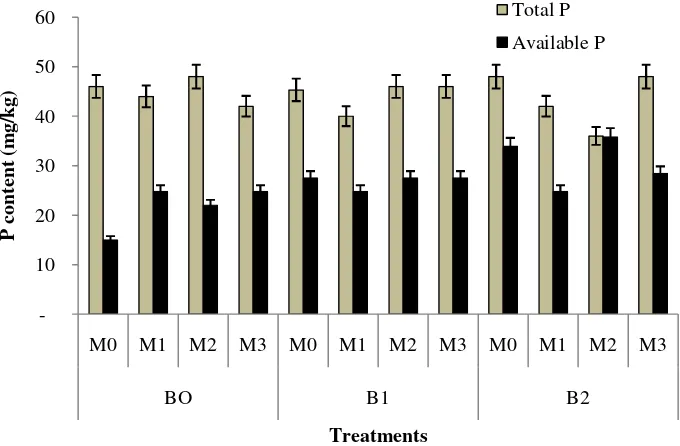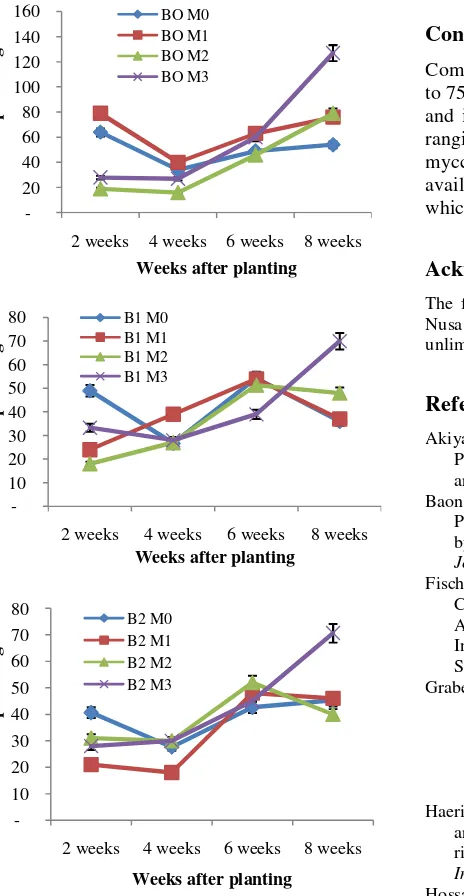ISSN: 2339-076X, Volume 1, Number 2 (January 2014): 69-74
Research Article
Effects of biochar amendment and arbuscular mycorrhizal fungi
inoculation on availability of soil phosphorus and growth of maize
A.E. Mau
1 *, S.R. Utami
1,2 1Postgraduate Program, Faculty of Agriculture, Brawijaya University, Jl. Veteran No 1, Malang 65145, Indonesia 2
Department of Soil Science, Faculty of Agriculture, Brawijaya University, Jl. Veteran No 1. Malang 65145, Indonesia
* Corresponding author: [email protected]
Abstract:
A glasshouse experiment was conducted to study the interactive effects of biochar amendment and arbuscular mycorrhizal fungi (AMF) inoculation on phosphorus uptake by maize (Zea mayze L.) grown on a calcareous soil of Kupang, East Nusa Tenggara. The biochar was made of cow dung. Twelve treatment combinations (three biochars levels of 0, 5 and 7.5 g/kg of soil, and four AMF inoculation levels of 0, 5, 10 and 15 spores / kg of soil) were arranged in a completely randomized block design with three replicates. Results of the study showed that at 8 weeks after transplanting, the biochar and mycorrhizal treatments increased the availability soil phosphorus and phosphorus uptake by maize. Application 4.5 and 7.5 g biochar/kg of soil combined with inoculation of 10-15 AMF spores / kg of soil provided to high value of phosphorus uptake by maize. Application of biochar alone, however, did not significantly improve maize growth and phosphorus uptake by maize.Keywords:arbuscular mycorrhizal fungi, biochar, calcareous soil, maize, phosphorus uptake.
Introduction
Dry climate conditions with a short rainy period and a long dry season, and the relatively high average annual air temperature are several factors that limit crop performance in East Nusa Tenggara of Indonesia. Soils in the area are characterized by low phosphorus availability due to binding of Ca to P that limits crop growth and yield. Fertility of the soils can easily be improved by application of inorganic fertilizers or fresh organic matters. However, most farmers cannot afford to purchase commercial inorganic fertilizers because of their low-income conditions. Dry climatic conditions of the area limits availability of fresh organic materials such plant residues and farm-yard manures. In addition, decomposition of fresh organic materials contributes to carbon dioxide emission (Lehman et al., 2003). One of possible alternatives to improve fertility of the soil, particularly soil phosphorus availability, is inoculation of arbuscular mycorrhizal fungi (AMF). Arbuscular mycorrhizal fungi are known to form mutualistic relationships with more than 80% of plants (Ulrich et al., 2002). This
secreted by plant roots (e.g. CO2, flavonoids, sesquiterpenes and strigolactones) can increase the branching of mycorrhizal hyphae and is expected to increase P uptake in maize to support the growth and productivity of maize crop. In addition Biochar can also be a good habitat for mycorrhizal growth. Yamato et al. (2006) revealed that biochar can lead to changes in physical and chemical properties of the soil and resulted in increased nutrient availability in the soil and increase plant root colonization by mycorrhizal fungi. According to Lehmann et al. (2003), biochar addition can improve plant productivity directly as a result of its nutrient content and release characteristics, or indirectly, through improved nutrient retention. Since AMF and biochar can both improve crop performance, there is an increasing interest in understanding their potential synergisms in increasing phosphorus availability of calcareous soils and phosphorus uptake by maize to improve overall maize crop performance. The objective of this study was to investigate the effects of biochar amendment and arbuscular mycorrhizal fungal inoculation on phosphorus availability phosphorus and growth of maize on a calcareous soil of East Nusa Tenggara, Indonesia.
Materials and Methods
The study was conducted in December 2012 -May 2013 at a glasshouse of the Faculty of Agriculture Nusa Cendana University, Kupang. Top soil (20 cm depth) of an Alfisol collected from Oebelo Kupang was used for the study. The soil is a predominantly sandy loam with 18%N,10% total P, 15.5 mg P2O5/kg, 0.59 me K/100g, 26.71 me Ca/100 g, and pH of 7.02. The mycorrhizal spore propagules of the site were less than 1 /kg soil. The soil was not fumigated prior to experimentation.
Twelve treatment combinations (three biochars levels of 0, 5 and 7.5 g/kg of soil, and four AMF inoculation levels of 0, 5, 10 and 15 spores / kg of soil) (Table 1) were arranged in a completely randomized block design with three replicates. For each treatment, three pre-germinated maize seeds were planted into a plastic pot containing 10 kg or air-dried soil. The maize was grown for 8 weeks. Each pot received basal fertilizers of 7.5 mg N/kg, 7.5 mg P2O5/kg, 7.5 mg K2O/kg and 5 mg S/kg (supplied as Phonska). Each pot also received 2.5 kg ground cow dung /kg. The cow dung contains 4.5 mg P2O5/kg. The addition of fertilizer and manure made the initial content of P2O5in the soil was 27.5 mg P2O5/kg. During the experiment, water was regularly supplied to ensure that water did not limit plant
growth. Biochar was produced at the Faculty of Agriculture, Nusa Cendana University of Kupang, from cow dung. The equipment used for preparing biochar was a simple pyrolysis drum having 55 cm high, 45 cm in diameter, and 20 cm diameter of an opening / closing hole. Prior to heating, cow dung was air dried, cleaned, and sieved to get particles size of 1.5 mm - 2.3 mm (8-10 mesh) (Sparkes and Stoutjesdijk, 2011). The pyrolysis temperature was maintained at 450ºC for 1 hour. Plant height was measured at 2, 4, 6 and 8 weeks after planting. At harvest (8 weeks), maize dry weight, total soil P, available soil P, P uptake by maize and the growing amount of spore per 50 g of soil were measured at 2, 4, 6 and 8 weeks after planting. Data obtained were subjected to analysis of variance using Minitab followed by 5% least significance different test.
Table 1. Treatments
Code Description
B0M0 no biochar, no mycorrhiza (control) B1M0 5 g biochar/kg, no mycorrhiza B2M0 7.5 g biochar/kg, no mycorrhiza B0M1 no biochar, 5 mycorrhiza spore/kg B1M1 5 g biochar/kg, 5 mycorrhiza spore/kg B2M1 7.5 g biochar/kg, 5 mycorrhiza
spores/kg
B0M2 no biochar, 10 mycorrhiza spore/kg B1M2 5 g biochar/kg, 10 mycorrhiza spore/kg B2M2 7.5 g biochar/kg, 10 mycorrhiza
spores/kg
B0M3 0 g biochar/kg, 15 mycorrhiza spore/kg B1M3 5 g biochar/kg, 15 mycorrhiza spore/kg B2M3 7.5 g biochar/kg, 15 mycorrhiza
spores/kg
Results and Discussion
Plant heightMajor et al. (2009) found only a significant yield response in maize in the subsequent cropping year. Despite the clear evidence that increased yield is usually observed in subsequent years, some authors found positive results in the first year. For instance, in cherry tomato, Hossain et al. (2010) reported a 20% yield increase with combined biochar and fertilizer. In their studies, they used a low pH chomosol with 10 t/ha of biochar applied. The absence of a clear plant growth increase in this study could partly be attributed to the soil used (basic), number of growing seasons and application frequency. The greatest plant height was observed for AMF inoculation of 50 spores / pot (M1) (Table 1).
However, the plant height of treatments with no AMF inoculation were only significantly different (p < 0.05) at 6 weeks, whereas at 8 weeks the plant height of treatments with no AMF inoculation were only significantly different from those of AMF inoculation of 150 spores / pot (M3). This non significant effect of AMF inoculation was probably due environmental adaptability problem of AM inoculants that were originated from Java and/or due to the present of indigenous AMF in the soil. Kuyper et al. (2004) argued that environmental factors influence the development of AMF and colonization of the fungi to the roots.
Table 1. Height of maize at 2, 4, 6 and 8 weeks
Mycorrhiza treatment Plant height (cm)
2 weeks 4 weeks 6 weeks 8 weeks
M0 (0 spores / kg of soil) 24.59 a 37.39 a 55.51 a 66.89 a
M1 (5 spores / kg of soil) 28.10 a 37.93 a 68.18 c 72.57 a
M2 (10 spores / kg of soil) 27.71 a 35.91 a 62.58 b 70.50 a
M3 (15 spores / kg of soil) 28.82 a 38.88 a 63.25 bc 71.84 a
Total soil P
Biochar amendment and AMF inoculation significantly affected total soil P content at week 8 (Table 2). This significant increase of total soil P indicated the improved balance of soluble and adsorbed P (Nursyamsi and Setyorini, 2009). The significant effect of biochar and its interaction with AMF on the increase total soil P was probably related to the supply of high surface area provided by biochar (400-800 m2/g of soil) which created a better habitat for the development and activities of soil microorganisms, which in turn increased the availability of soil P (Fiscer and Glaser, 2012).
Available soil P
Availability of soil P significantly decreased from 30 to 4 weeks after planting but no significant decrease was observed at weeks 6 and 8 (Figure 1). Application of 5 g biochar/kg of soil (treatment B1) significantly decreased availability of soil P at 4 weeks. At 6 weeks, however, application of 5 g biochar/kg significantly increased P availability in the soil. The highest increase of soil available P was observed for the B2M2 treatment (7.5 g biochar/kg and 10 AMF
Figure 1. Total and available soil P as affected by biochar amendment and AMF inoculation. *) see Table 1
Uptake of P by maize
Uptake of P by maize was improved by biochar amendment and AMF inoculation (Figure 2). Compared to the control (B0M0), biochar amendment and AMF inoculation increased P uptake by maize from 3.6% (B0M3) to 62.7% (B2M2). This indicates that a combined application of biochar and AMF improved availability of soil P and uptake of P by maize which in turn improved plant yield. Saranya et al.
(2011) reported that biochar treatment with standard 25 t/ha can increase P uptake in maize more than 15 mg / kg and did not differ significantly with biochar treatment of 10 t/ha and 15 t/ha. According to Rondon et al. (2007), application of biochar to 30 g/kg soil can increase P uptake up to 7 mg/pot on legumes. According to Pamuna et al.(2013), AMF can increase P uptake in maize to 300 kg P/ha as well as to increase the availability of P in the soil.
Figure 2. Uptake of P by maize as affected by biochar amendment and AMF inoculation. *) see Table 1
-10 20 30 40 50 60
M0 M1 M2 M3 M0 M1 M2 M3 M0 M1 M2 M3
BO B1 B2
P
co
n
te
n
t
(m
g
/k
g
)
Treatments
Total P
Available P
-5 10 15 20 25 30 35
M0 M1 M2 M3 M0 M1 M2 M3 M0 M1 M2 M3
BO B1 B2
P
u
p
tak
e
b
y
m
ai
ze
(m
g
/p
o
t)
Mycorrhizal spore
There was a good response of mycorrhiza to the AMF inoculation 15 spores/kg of soil (Figure 3). The decline in number of spores in the early planting period was expected because the inoculated AMF that were originated from outside of the study area had not yet been able to make adjustment to the existing environmental factors, Kuyper et al. (2004) suggested that environmental factors influence the development of sufficient and colonization of mycorrhizal fungi to the roots, especially in the different conditions between the native habitat mycorrhizal growth/development of the host plant.
Figure 3. Number mycchorizal spores due to application of biochar *) see Table 1
Baon et al.(2008) identified that changes in soil temperature greatly influenced the development of mycorrhiza, in which the interaction between the development of mycorrhiza and soil temperature will affect P uptake by the host plant. The types of mycorrhiza identified in this study in were
Glomus sp, Gigaspora, Scutellospora and
Acaulospora. The most varied types of spores were found in the B2M0 treatment (7.5 g biochar/ kg of soil with no AMF inoculation). The types of mycorrhizal spores found in this study were similar to those reported by Haerida and Karmadibrata (2002) who identified the origin of mycorrhizal fungi spores on sweet maize plant in Java.
Conclusion
Combined application of biochar ranging from 5 to 75 kg biochar (equivalent to 10-15 t biochar/ha) and inoculation of mychhoriza arbuscular spores ranging from 5-15 spores/kg (equivalent to 50-15 mycchoriza arbuscular spores/ha) improved availability of soil P and uptake of P by maize which in turn improved plant yield.
Acknowledgements
The first author thanks to the Faculty of Agriculture, Nusa Cendana University, Kupang for providing unlimited access to the faculty to support this study
References
Akiyama, K., Matsuzaki, K.I. and Hayashi, H. 2005. Plant sesquiterpenes induce hyphal branching in arbuscular mycorrhizal fungi.Nature435:824–827 Baon, J.B., Smith, S.E. and Alston, A.M. 2008.
Phosphorus uptake and growth of barley as affected by soil temperature and mycorrhizal infection.
Journal of Plant Nutrition17: 479-492.
Fischer, D. and Glaser, B. 2012. Synergisms Between Compost and Biochar for Sustainable Soil Amelioration “Management of Organic Waste”. Institute of Agricultural and Nutritional Sciences, Soil Biogechemistry, Halle. Germany
Graber, E.R., Harel, Y.M., Kolton, M., Cytryn, E., Silber, A., David, D.R., Tsechansky, L., Borenshtein, M. and Elad, Y. 2010. Biochar impact on development and productivity of pepper and tomato grown in fertigated soilless media.Plant Soil337: 481–496
Haerida, I. and Kramadibrata, K. 2002. Identification of arbuscular mycchorizal fungi in sweet maize plant rizhosphere of Java.Floribunda Jurnal2: 33-37. (in Indonesian)
Hossain, M.K., Strezov, V., Chan, K.Y. and Nelson, P.F. 2010. Agronomic properties of wastewater sludge biochar and bioavailability of metalsin
-2 weeks 4 weeks 6 weeks 8 weeks
N
2 weeks 4 weeks 6 weeks 8 weeks
N
2 weeks 4 weeks 6 weeks 8 weeks
production of cherry tomato (Lycopersicon esculentum). Chemosphere78: 1167–1171
Ishii, T. and Kadoya, K. 1994. Effects of charcoal as a soil conditioner on citrus growth and vesicular– arbuscular mycorrhizal development. Journal of Japanese Society of Horticultural Science63: 529– 535
Javaid, A. and Riaz, T. 2008. Mycorrhizal colonization in different varieties of Gladiolus and its relation with plant vegetative and reproductive growth.
International Journal of Agriculture and Biology
10: 278–282
Javaid, A., 2009. Arbuscular mycorrhizal mediated nutrition in plants. Journal of Plant Nutrition 32: 1595–1618
Kimetu, J., Lehmann, J., Ngoze, S.O., Mugendi, D.N., Kinyangi, J.M., Riha, S., Verchot, L., Recha, J.W. and Pell, A.N. 2008. Reversibility of soil productivity decline with organic matter of differing quality along a degradation gradient. Ecosystems
11: 726–739
Kuyper T.W., Cardoso, I.M., Onguene, N.A., Murniati and van Nordwijk, M. 2004. Managing Mycorrhiza in Tropical Multispecies Agroecosystems. In M. van Nordwijk, G. Cadisch dan C.K Ong. Below Ground Interactions in Tropical Agroecosystems, CAB International.
Lehmann, J., Silva Jr., P.J., Steiner, C., Nehls, T., Zec, W. and Glaser, B. 2003. Nutrient availability and leaching in an archaeological Anthrosol and a Ferralsol of the Central Amazon basin: fertilizer, manure and charcoal amendments. Plant and Soil
249: 343–357
Major, J., Rondon, M., Molina, D., Riha, S.J. and Lehmann, J. 2010. Maize yield and nutrition during 4 years after biochar application to a Colombian savanna oxisol.Plant and Soil333: 117–128 Major, J., Steiner, C., Downie, A. and Lehmann, J.
2009. Biochar Effects on Nutrient Leaching. In: Lehmann J, Joseph S (eds) Biochar for Environmental Management. Earthscan Publications Ltd. ISBN: 9781844076581, pp 271-287
Nursyamsi, D. and Setyorini, D. 2009. Availability of P in neutral and alkaline soils. Journal of Soil and Climate30: 1-12. (in Indonesian)
Oseni, T.O., Shongwe, N.S. and Masarirambi, M.T. 2010. Effect of arbuscular mycorrhiza (AM) inoculation on the performance of tomato nursery seedlings in vermiculite. International Journal of Agriculture and Biology12: 789–792
Pamuna, K., Darman, S. and Patadungan, Y.S. 2013. Effects of SP-36 fertilizer and arbuscular mycchorizal fungi on uptake of P by maize grown on an Oxic Distrudept of Lemban Tongoa.Journal of Agrotekbis1: 9-14. (in Indonesian).
Rondon, M, Lehmann, J., Ramirez, J. and Hurtado, M. 2007. Biological nitrogen fixation by common beans (Phaseolus vulgaris L.) increases with biochar additions.Biology and Fertility of Soils43: 699-708.
Saranya, K., Kumutha, K. and Krishnan, P.S. 2011. Influence of biochar and Azospirillum application on the growth of maize. Madras Agricultural Journal98: 158-164
Sparkes, J. and Stoutjesdijk, P. 2011. Biochar: Implications for Agricultural Productivity. Technical Report, Department of Agriculture, Fisheries and Forestry, Australian Governments Ulrich, H., Katharina, J. and Hermann, B. 2002.
Towards growth of arbuscular mycorrhizal fungi independent of a plant host.Applied Environmental Microbiology,68: 1919–1924
Van Zwieten, L., Kimber, S., Morris, S., Chan, K.Y., Downie, A., Rust, J., Joseph, S. and Cowie, A. 2010. Effect of biochar from slow pyrolysis of papermill waste on agronomic performance and soil fertility.Plant and SoilJournal 327: 235-246 Verheijen, F.G.A., Jeffery, S., Bastos, A.C., van der
Velde, M. and Diafas, I. 2009. Biochar Application to Soils - A Critical Scientific Review of Effects on Soil Properties, Processes and Functions. EUR 24099 EN, Office for the Official Publications of the European Communities, Luxembourg, 149pp. Warnock, D.D., Daniel, L., Mummey, D.D., Mcbride,
B., Julie-Major, J., Lehmann, J. and Rillig, M.C. 2010. Influences of non-herbaceous biochar on arbuscular mycorrhizal fungal abundances in roots and soils: Results from growth-chamber and field experiments.Applied Soil Ecology46: 450–456 Warnock, D.D., Lehmann, J., Kuyper, T.W. and Rillig,
M.C. 2007. Mycorrhizal responses to biochar in soil–concepts and mechanisms.Plant and Soil300: 9–20



